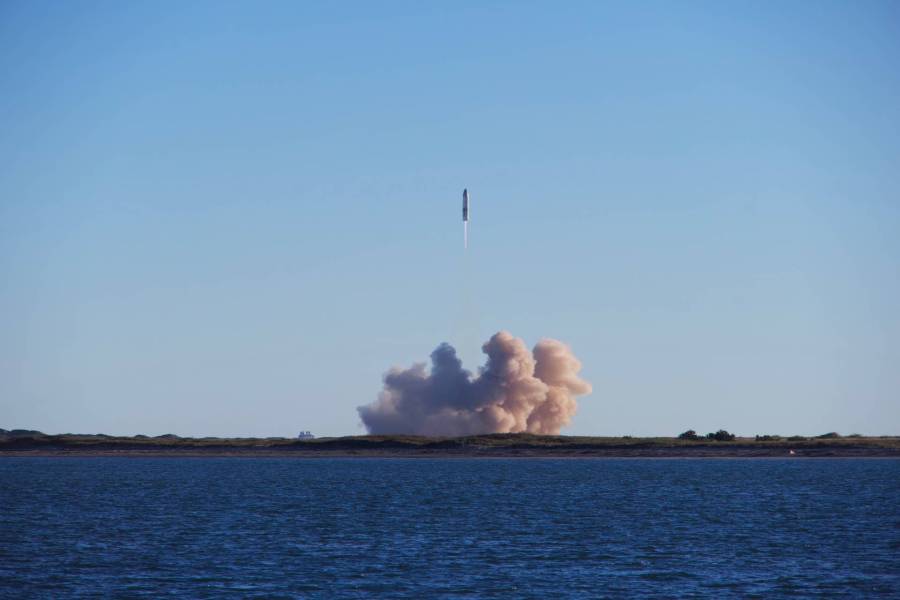SpaceX, the renowned aerospace manufacturer and space transportation company founded by Elon Musk, recently conducted a full-pressure test of a new water deluge system for its Starship launch vehicle. This test is a significant step towards resolving one of the major problems that arose during the orbital flight test in April, where the heat and energy from the Super Heavy booster’s engines damaged the launch pad and orbital launch mount. In this article, we will delve into the details of SpaceX’s innovative solution and explore the environmental considerations surrounding this new system.
To protect against the immense heat and force generated during the Starship launch, SpaceX has developed what CEO Elon Musk refers to as a “mega-steel pancake.” This water deluge system consists of a thick perforated steel plate placed directly underneath the rocket, along with multiple large water jets that continuously cool the rocket with water, even in the presence of flames from the rocket engine.
Elon Musk shared a tweet showcasing the new water deluge system, stating, “New water deluge system to protect against the immense heat & force of Starship launch.” The accompanying video posted on X by Musk provides a glimpse of the test, suggesting a substantial amount of water is discharged during a full-pressure spray.
While the water deluge system appears to be an effective solution for protecting the launch infrastructure, there are environmental concerns surrounding the use of such a system. It has been reported that SpaceX did not apply for an environmental permit for disposing of industrial process wastewater as required by the U.S. Clean Water Act. However, it remains unclear whether SpaceX actually needs such a permit.
The key question is whether pollutants, such as chemicals, may mix into the water as it sprays up at the rocket. If this is the case, SpaceX will need to implement a process for disposing of the water without causing harm to the surrounding wetlands. The Texas Commission on Environmental Quality (TCEQ) is currently evaluating the new deluge system to determine if any environmental regulations apply.
A representative from TCEQ mentioned that the need for a discharge permit is the responsibility of the business owner based on their wastewater management plan. While the evaluation process is ongoing, SpaceX seems confident in the effectiveness of their water deluge system. With the installation of the steel plate, the company is now closer to conducting pre-launch testing on Booster 9, the Super Heavy prototype for the upcoming test flight.
Before SpaceX can proceed with the next Starship flight test, they must obtain approval from the U.S. Federal Aviation Administration (FAA). The FAA, as the regulatory authority for all rocket launches, grounded the Starship after the last test resulted in a mid-air explosion. While the grounding was expected given the outcome of the test, SpaceX still needs regulatory approval for the next flight test.
In addition to the FAA’s approval process, SpaceX is also a co-defendant in a lawsuit filed by environmental and Indigenous groups. The lawsuit alleges that the FAA failed to fully assess the environmental effects of SpaceX’s activities in the Starbase area, where the Starship launch program is centered. Although the lawsuit is in its early stages, it poses the potential to delay Starship’s future flights.
In summary, cSpaceX’s development of the “mega steel pancake” water deluge system marks a significant advancement in ensuring the safety and integrity of the Starship launch infrastructure. The company’s innovative solution to protect against the intense heat and force generated during launch demonstrates their commitment to pushing the boundaries of space technology.
While environmental concerns and regulatory considerations remain, SpaceX is actively working with the Texas Commission on Environmental Quality to evaluate the impact of the water deluge system. The outcome of this evaluation will determine the necessary steps SpaceX needs to take to comply with environmental regulations.
As SpaceX awaits regulatory approval from the FAA for their next flight test, they also face potential delays due to the ongoing lawsuit regarding the environmental review of Starbase and the Starship launch program. Despite these challenges, SpaceX continues to push forward, aiming to revolutionize space travel and exploration with their groundbreaking technologies.
Stay tuned for more updates on SpaceX’s progress as they pave the way for the future of space exploration.
First reported on TechCrunch
Frequently Asked Questions
1. What is SpaceX’s water deluge system, and why is it significant?
SpaceX’s water deluge system, also known as the “mega-steel pancake,” is designed to protect the launch infrastructure during Starship launch missions. It consists of a thick perforated steel plate placed under the rocket and multiple large water jets that continuously cool the rocket, even in the presence of rocket engine flames. This system is a significant advancement in ensuring the safety and integrity of the Starship launch infrastructure.
2. What was the major problem that arose during the orbital flight test in April?
During the orbital flight test in April, the heat and energy from the Super Heavy booster’s engines damaged the launch pad and orbital launch mount. The water deluge system is SpaceX’s innovative solution to address this issue.
3. Has SpaceX applied for an environmental permit for the water deluge system?
There are environmental concerns surrounding the use of the water deluge system, and it has been reported that SpaceX did not apply for an environmental permit for disposing of industrial process wastewater as required by the U.S. Clean Water Act. However, the need for a discharge permit depends on the evaluation of the system’s impact by the Texas Commission on Environmental Quality (TCEQ).
4. How is TCEQ evaluating the water deluge system’s impact?
TCEQ is currently evaluating the water deluge system to determine if any environmental regulations apply. They are assessing whether pollutants, such as chemicals, may mix into the water as it sprays up at the rocket. The outcome of this evaluation will determine the necessary steps SpaceX needs to take to comply with environmental regulations.
5. What is the status of the FAA’s approval for SpaceX’s next flight test?
Before SpaceX can proceed with the next Starship flight test, they must obtain approval from the U.S. Federal Aviation Administration (FAA). The FAA, as the regulatory authority for all rocket launches, grounded the Starship after the last test resulted in a mid-air explosion. SpaceX is awaiting regulatory approval for the next flight test.
6. What is the current situation regarding the lawsuit against SpaceX?
SpaceX is a co-defendant in a lawsuit filed by environmental and Indigenous groups, alleging that the FAA failed to fully assess the environmental effects of SpaceX’s activities in the Starbase area, where the Starship launch program is centered. The lawsuit is in its early stages and could potentially lead to delays in Starship’s future flights.
7. What does SpaceX’s progress with the Starship launch program signify for space exploration?
SpaceX’s continued development and advancement of the Starship launch program demonstrate their commitment to pushing the boundaries of space technology and revolutionizing space exploration. The water deluge system is a key part of their efforts to ensure safe and successful launch missions.
8. How can readers stay updated on SpaceX’s progress with the Starship launch program?
Readers can stay informed about SpaceX’s progress by following official announcements from SpaceX and reputable news sources covering space exploration and technology. Regular updates from SpaceX and reliable media outlets will provide the latest developments and milestones in the Starship launch program.
Featured Image Credit: Unsplash


















